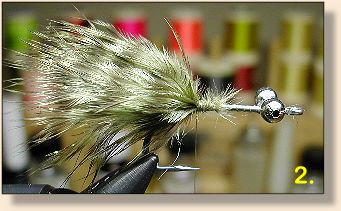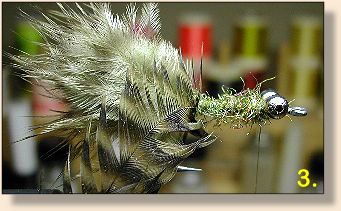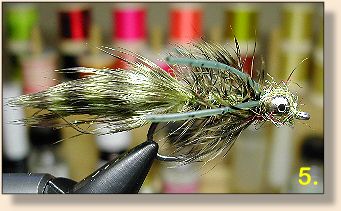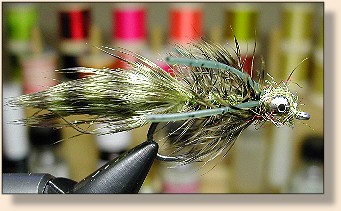|
Dragonfly nymphs are a major source of nutrition for Trout
in stillwaters. Their size and availability make them desirable
to the finned creatures, but their complicated configuration causes
no small amount of distress to the fly tier who seeks to imitate
them. A massive, horizontally swelled abdomen, long legs, flat
body, and mottled colour scheme make their appearance intimidating
to replicate. On top of it all, they are bottom-dwelling creatures
which requires some amount of weight in the fly for it to be a
believable representation.
Over the span of time, many Dragonfly patterns have come and gone.
Most are extremely bulky and difficult to cast. Others that have
been simpler to cast are not very good imitations. Then again,
some of the good imitations require a vast amount of materials
and techniques that are beyond the skills of the beginner,
frustrating for the intermediate tier, and annoying to the expert.
Some new ideas are needed to make this easier, to be sure!
Here are a few ideas combined in a fly called "Fafner" after another
entity of similar type and the same name to make the concept more
simplified while still retaining accuracy. Essentially a Bugger
with minor modifications, it is designed to sink quickly and give
the impression of the large-headed nymph with its segmented body
and long legs all the while keeping the tying process simple.
If you can tie a Woolly Bugger, you can tie Fafner. Here are
the details:
Materials: Fafner
Hook: Saltwater or Bass hook, #4-#10.
Tail: Grizzly dyed Olive Marabou.
Body: Olive dubbing.
Hackle: Grizzly dyed Olive schlappen.
Legs: Olive rubber strands.
Tying Steps:

1. Lash bead chain eyes to hook and superglue them for stability.

2. Wind thread to hook bend and tie in grizzly/olive marabou.
I have added a couple strands of root beer Krystal Flash for effect:
this is optional, of course. The grizzly marabou is available
from Ewing Feather Birds in many dyed shades.

3. Tie in a schlappen or other long, webby hackle by its tip.
Wind a body of dubb or chennille. I dislike chennille, and am
therefore making the body with Ronn Lucas, Sr's. Iridescent
Dubbing. Any loose, shaggy dubbing will do. If you should decide
to use chennille, add a wire rib to protect the hackle rachis.
Dubbing will cushion it from the terrors of Trout teeth if not.

4. Wind the hackle forward and make a full collar behind the
eyes. Tie in a pair of long rubber legs between the collar
and the eyes.

6. Dub over the eyes and whip finish. This last part might
seem academic, but don't forget that Dragonfly nymphs have big
heads! (So did the original Fafner, by the by.)
More Tips
Adjust the materials to adapt to the hues of your local
dragons, but make sure the tail and legs are dyed-over-grizzly
or in some other way variegated. This is what makes that
abdomen look segemented without having to wrap Larva Lace
or other items around a hook or extension.
If these will be used in pursual of Bass, a stinger hook is a
good choice, but it requires larger eyes in order to cause it
to ride hook-up. The fly looks the same top and bottom, so if
it does not turn over, all you lose its the weedless quality,
but it is something of which one will want to be aware when
selecting a hook. Streamer hooks, for instance, look nice,
but certain downeye types don't "roll" like short shank hooks
do. Curved shank hooks like the 200R are good, as are most
Saltwater hooks. Coincidentally, I also like to tie these
with lead eyes if they will be fished in deeper stretches
of water. ~ TD
|



